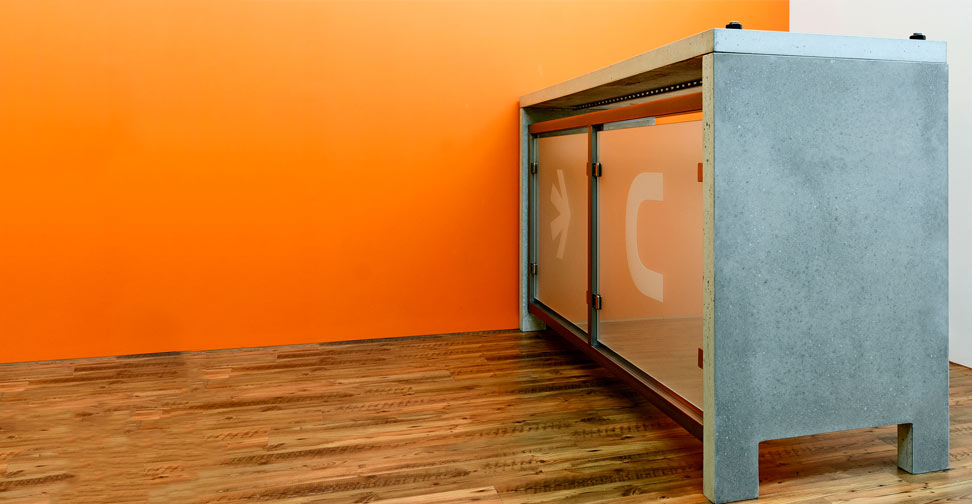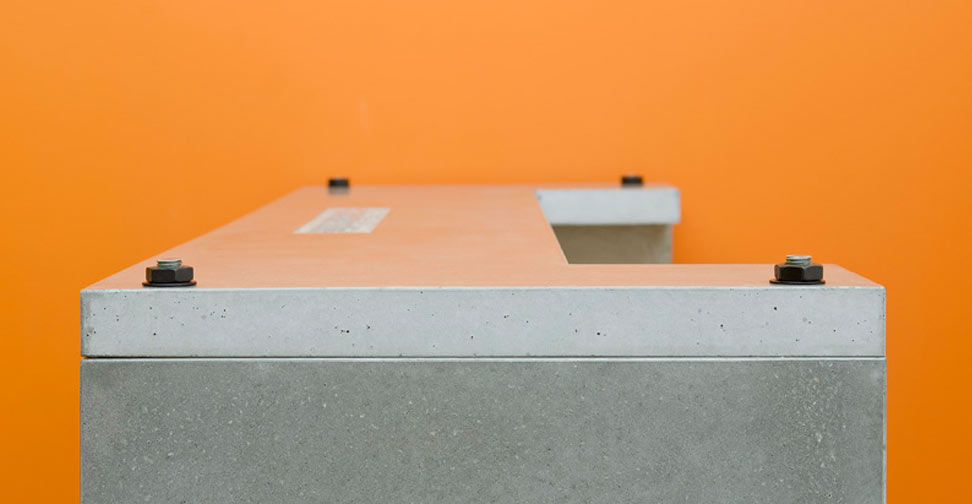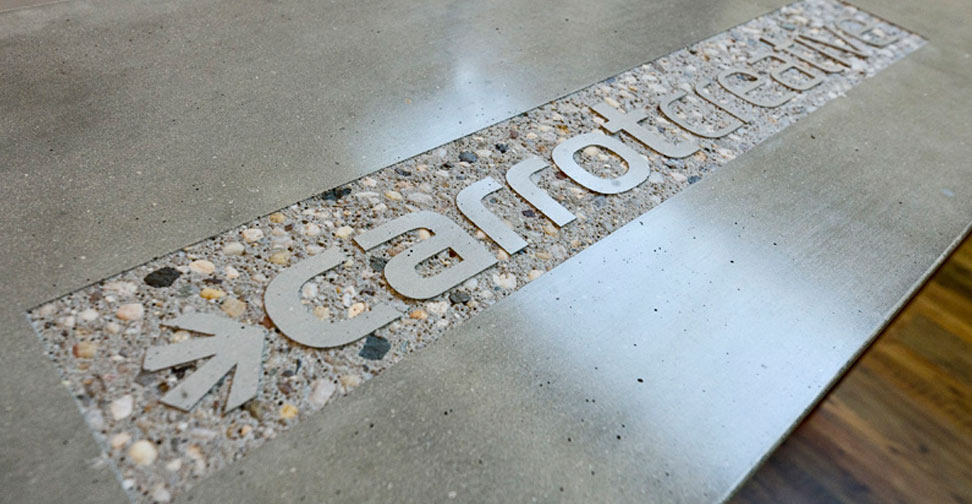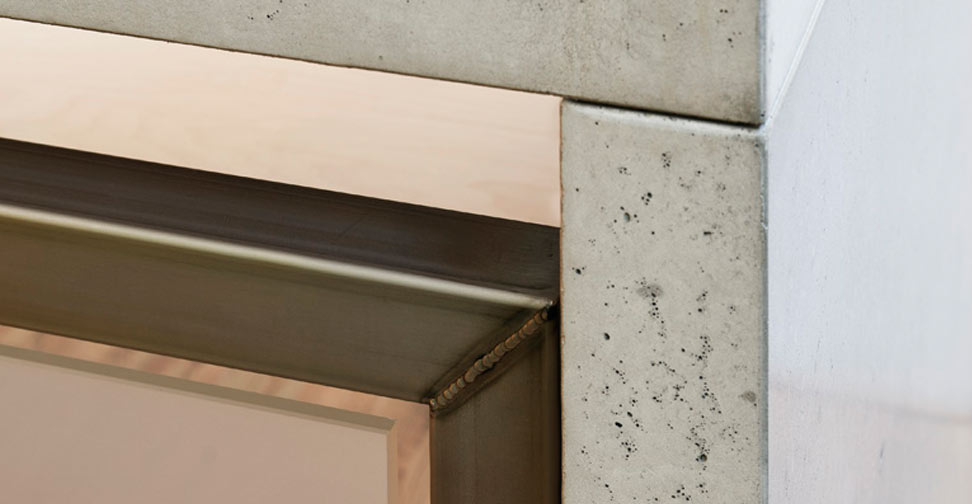Share this Post
Concrete Carrot
Paul Wood’s Concrete Carrot Desk took 10 weeks to complete and is located in DUMBO, Brooklyn, NY. It weighs over 1,000 lbs and was made with CHENG Platinum Pro-Formula Concrete Countertop Mix with etched glass doors and steel frame. It was awarded a Presidents’ Award in the 2012 CHENG Concrete Circle of Distinction Design Challenge by CHENG Concrete co-presidents Annalyn Chargualaf-Peluso and Mike Heidebrink. Wood’s extensive furniture-making experience conquered the challenges of producing a massive piece that brilliantly showcases concrete, glass, and steel.
Project Objective + Client Feedback
What was the client’s objective for the project?
Paul: The client – a digital design and marketing agency – is on the top floor of a building in the DUMBO neighborhood of Brooklyn, which looks directly over the Manhattan Bridge and the Manhattan skyline. They wanted something big and bold, but which also had classic lines that would stand the test of time. And because the firm uses Apple computers exclusively, they were seeking a furniture design that would complement the simple, clean lines of Apple’s design aesthetic.
What made this project unique/ important?
Paul: My workshop is in the Brooklyn Navy Yard, and I draw a lot of my inspiration from the surrounding environment – it’s this wonderful tension between industrial elements, the waterfront, and a growing mix of business and residential activity. It always excites me to work on projects in the Brooklyn and downtown Manhattan areas because there are so many disparate elements that all somehow work together. One of the most compelling things about the job was that I would be using multiple different materials, which meant that I would need to collaborate with other people and disciplines – it was such a perfect parallel to the environment I work in daily, and which inspires much of my design sensibility. I was also drawn to the fact that the project was being commissioned by a highly creative group, which gave me the runway I needed to experiment with my own creativity.
Another thing, which perhaps put the biggest smile on my face, was when we pulled the glass piece out of the sand blasting bay to see the logo etched into the top. First of all, I could breathe again, knowing that the lettering was sharp and clean; and second, the actual look left by the blasting and the pattern of the aggregate it had exposed was so beautiful. It was very gratifying.
Was there any special challenge of the project that you overcame? What was it and how did you meet that challenge?
Paul: Challenges. There were many on this job. Here’s my Letterman Top Ten List of “everything seemed to have an event-filled edge to it”:
- My small studio space.
- Getting the piece to and from sand blasting.
- Getting the piece in the sand blasting booth.
- How to reinforce an 8 ft. stretch of concrete.
- Studio is on the third floor which makes water, mixing and clean up pretty interesting.
- I don’t have a large mixer so there was a lot of mixing and re-mixing.
- Budget too small.
- Delivery to 12th floor with an elevator change on the 10th floor.
- Relying on the kindness of people to help me lift, twist and flip the giant pieces of concrete.
- And the number one reason why “everything seemed to have an event-filled edge to it.”
- Installation…
How long have you been working with concrete as a decorative medium?
Paul: A few years, however, this was the first really meaty job that I had tackled.
Why was concrete used for this project as opposed to other materials?
Paul: The client was not interested in wood, as they had a wooden floor and thought that it would be too much. They also wanted something that looked weighty, so I convinced them to go with concrete. It was the perfect medium to meet their objectives, it was a beautiful complement to their geographic environs, and I wanted to build something substantial using concrete.
Did you use other materials besides concrete in your project?
Paul: Because the concrete desk was to be the centerpiece overlooking the Manhattan skyline, using a combination of concrete, steel and glass seemed perfect. Concrete and steel were the foundational materials showing strength; to a lesser degree, glass too. But this project had to appear light in design, so, for the construction, I decided to float the glass.
As noted earlier, one of the client’s requirements was that the piece speaks to the simple, clean lines of the Apple design. What I tried to come up with was a Stonehenge redesigned by Apple.
What was the client’s reaction to the finished project?
Paul: It was great. I thought that I was going to have to tranquilize one of the owners of the company because he was so excited—this almost made me forget my Letterman Top Ten List of “everything seemed to have an event-filled edge to it.”
2012 Presidents Award, CHENG Concrete Exchange Design Challenge
Recognized in the industry as the pinnacle of exceptional design and craftsmanship, the CHENG Concrete Exchange Design Challenge showcases talent and technical skill of the very best in creative concrete.
About Made by Wood
Paul Wood of Made by Wood in Brooklyn, New York, creates one-of-a-kind furniture from a variety of materials, having added concrete fabrication to his palette a few years ago.
About his work, Wood says, “One thing for sure is that my influences come from living in downtown New York City. I am surrounded by many of the oldest and tallest buildings in the city, most of which were built when details were seen as necessary as opposed to time-consuming and expensive. And in total contrast, the Battery Park woodland area is smack dab in the middle of it all. Making harmony out the incongruous juxtaposition of these elements is what inspires me. I draw on these architectural details and the organic nature of the trees that grace the southern tip of our beautiful island.”
Learn more about Made by Wood and their projects at custommade.com/by/madebywood.
Contact: Paul Wood
Made by Wood
15 Broad St
New York, NY 10005
(917) 207-4600
paul@madebywood.com
www.custommade.com/by/madebywood




